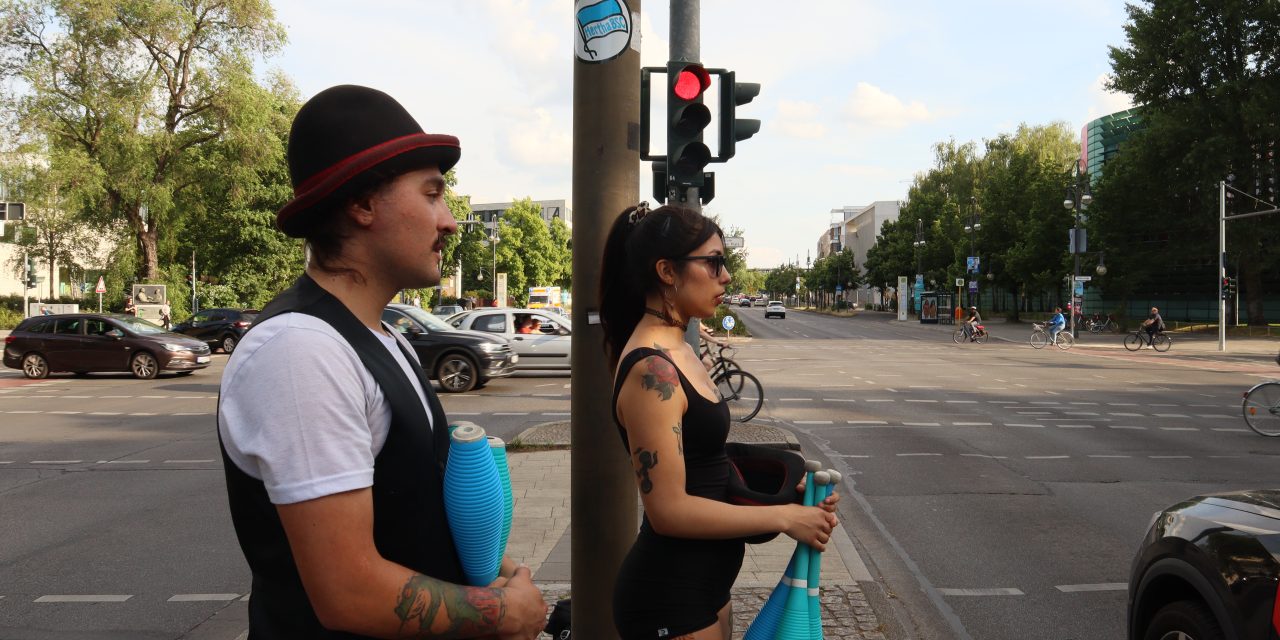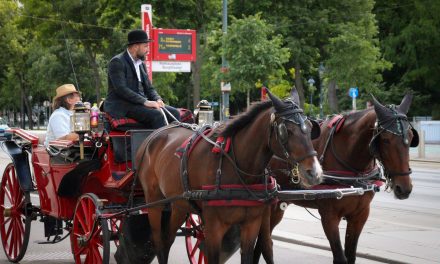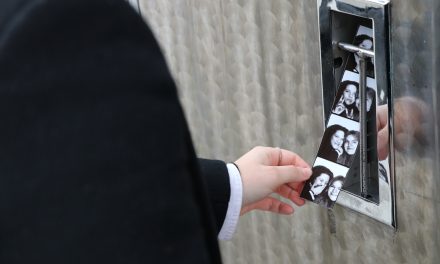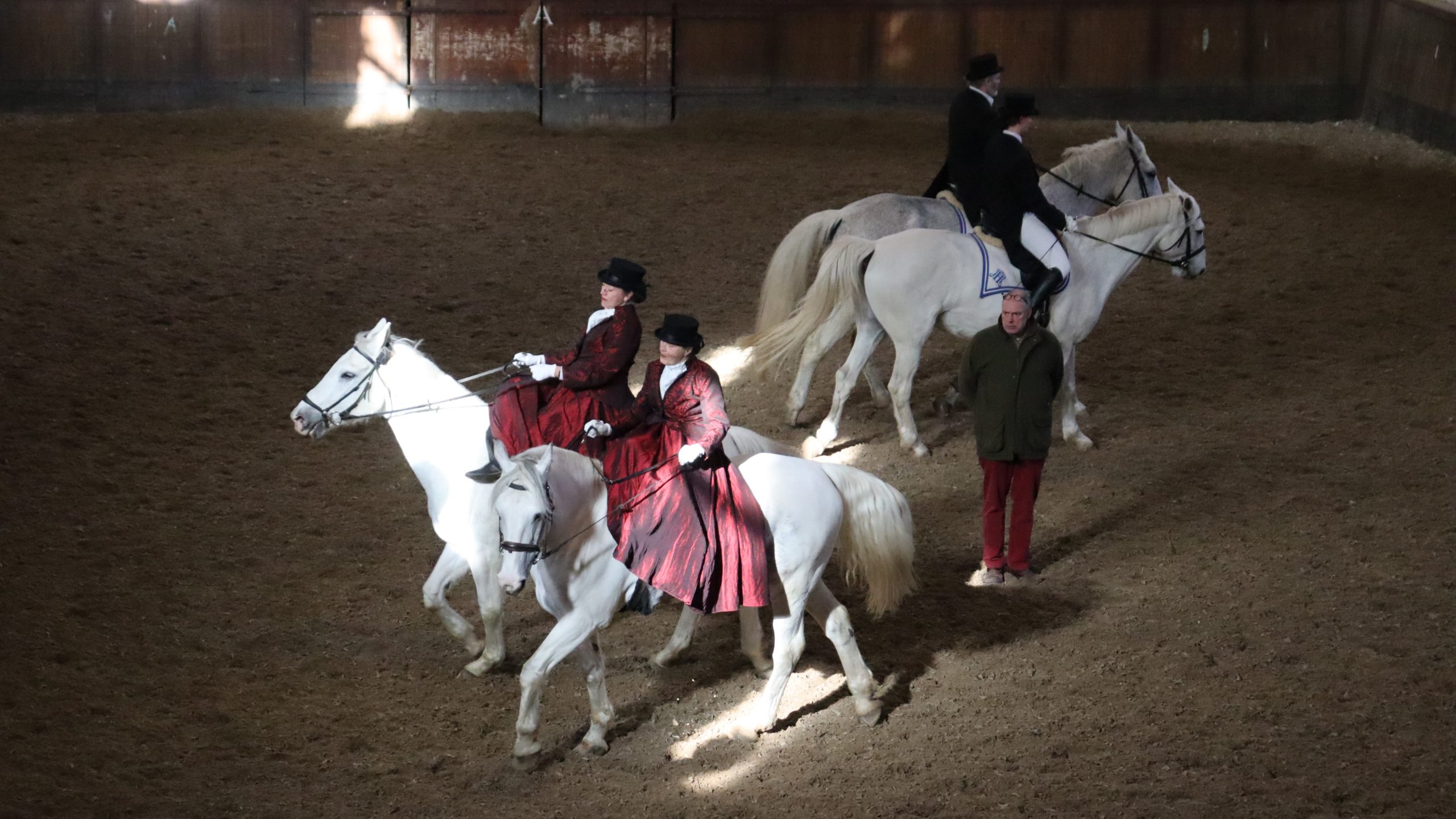Traffic light performing originated in South America, where performers see it as a way out of poverty. It’s a highly efficient way for street artists to make money. This way of performing is also becoming more common in Europe. For example in Berlin, where there are no specific rules governing the practice. What motivates performers to juggle at the traffic lights?
The traffic light turns red, and Isidora Adeley and her boyfriend Barra Nomas run to the crossing, shouting “Hello Amigos” in unison. They stand in front of a three-lane road at the Siegessäule in Berlin. With juggling clubs in their hands, they wave at the audience to get their attention. A few people look surprised, while others have a more annoyed look on their faces. Isidora and Barra start one of their routines, created specifically for a traffic light show. Both juggle five clubs while balancing one on their head. Then, just before the traffic light turns green, they quickly run through the cars to collect their tips for the performance. A man waves a ten-euro bill in his hand while shouting, “Wow, that was impressive, how many more can you juggle?” Isidora has no time to answer because the light turns green, and as the cars start driving. They hurry back to the traffic island and take a quick sip of water, before they do the whole thing again a minute later.
Legal gray area in Europe
In Europe, traffic light juggling generally falls into a legal gray area, as it is a unique form of street performing that doesn’t always fit neatly into existing categories. For example, in Spain, where there are comprehensive traffic rules and regulations enforced by the Directorate-General for Traffic (DGT) for all road users, these do not specifically address traffic light juggling. Performers must comply with general traffic laws related to public safety. In Paris, street artists need a license to perform in specific areas like the metro. In both Spain and France, as in other European countries, local regulations about public performances and safety must be followed, but specific rules for traffic light juggling are often not detailed.
Inge Cairns has been working for over five years in Kleine Zirkus Laden, a circus shop in Berlin. She has noticed an increase in traffic light performers visiting the shop. “It was mainly South Americans, who rarely spoke English or German. In the past two years, more Europeans have started performing at traffic lights. You can always tell, because they pay with very small money that they have collected while performing.” She has noticed that the most popular places for artists to perform is at the traffic lights in Mauerpark, Tempelhof, and Grosser Stern.
Motivation
Traffic light performing is driven by two main motivations: making money and expressing art. The study “Jugglers at the Traffic Lights” from Universidade Federal da Paraíba in Brazil found that 45% of performers in South America do it because they need income and can’t find regular jobs. Another 40% do it for artistic reasons, and 15% use it to support their travels. Juggling at traffic lights allows them to earn money while practicing and getting stage experience. It also provides a way for artists to express their creativity and bring art to public spaces, which makes it accessible to everyone. Motivations can be different in Europe, where the practice is growing. In South America it is almost a necessity for some people to make a living. In Europe, where poverty is less prevalent, artists might see traffic light juggling more as a way to practice their art form.
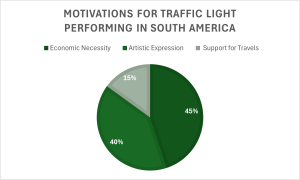
Isidora is from Chile and has been living in Berlin for two years now. “In South America, there are fewer opportunities, the schools aren’t as good, and it’s hard to find a decent job. That’s why many people start performing at traffic lights. Jugglers from South America are much more dedicated to their training because they’ve made it into a job. In Europe, artist have more opportunities outside of juggling, which is why I think it’s more common in South America.” She explained.
Five years ago Isidora started juggling. Also when she attended her first circus school in Argentina. Her friends did traffic light performances, so she began too, using her juggling skills to earn money. Isidora explains, “I came to Europe two years ago with my boyfriend, and since then we’ve been making a living out of traffic light performing. We work three to four times a week. The skill level is very important now because people in Berlin are getting used to traffic light jugglers. Since there are more and more jugglers, people expect more tricks.”
No law
Performing at traffic lights has its challenges. Sometimes people get angry and they call the police, however it’s not illegal since there is no specific law against it. Isidora still enjoys the freedom and flexibility of traffic light performing. She loves being able to practice and make money at the same time without having a boss.
In Berlin, busking has rules to keep things orderly. Whether traffic light performing is included in those rules is debatable, since it’s a different way of busking. Therefore traffic light juggling is a grey area. Anne-Lisa Domnig, the founder of Berlin Street Music, says, “Performers can play in public spaces, but they need to follow specific time and location rules.” They can perform from 8:00 AM to 1:00 PM and 3:00 PM to 8:00 PM, but not on Sundays or holidays. Anne-Lisa explains, “Loud instruments are often restricted to avoid disturbances.” Some places, such as parks and busy squares, may require buskers to have a permit, which involves a fee and an application. Traffic light performing does not really fit in with to those rules, but the rules can be seen as guidelines.
Lots of practice
Balancing making money with artistic expression can be tough. “My boyfriend and I work at the traffic light three to four times a week, which is about four to six hours of juggling per session. On top of that, I also need to practice for myself. Sometimes I’m tired after work, but I still force myself to train in a gym because otherwise, I won’t get better.”
New audience
Isidora finds traffic light performing easier than other street performances. It can be done all day, every day, especially in the late afternoon when people are going home from work. It’s an efficient way of making money because, as Isidora says, “every other minute you have a new audience, they just keep rolling.” Other street performances require more effort, but traffic light performances are quick and often impress people more easily. Performing at traffic lights doesn’t require a permit, unlike performing in parks or squares.
Busking is important for Berlin’s culture. Anne-Lisa says that after the Wall fell, there was more art and culture on the street than now, but as Berlin got busier, street performances became less common. She adds, “Street performers are a big part of Berlin’s identity. Street performance is important because it makes art accessible to everyone. Many people think art is expensive and out of reach, but street artists bring art to the streets so everyone can enjoy it. Art is supposed to be public, not something you have to buy.’’
Sometimes the buskers can get into conflict with authorities. Some people see the artists as beggars. Isidora says, “Some people don’t appreciate the art; they just think that we are doing nothing with our lives. They don’t see the hours of practice we put in.” Sometimes the police gets called and they have to leave.
Watch the video where Isidora and Barra perform at a traffic light in Berlin.
No taxes
Isidora, Barra, and other traffic light performers, who wish to remain anonymous, do not want to share the amount of money they make. Isidora explains, “I don’t want to share because this is how I make my money. If too much media attention is given, the government might make a law against it, which would prevent us from doing this art.” It is debatable if this is an ethical way of making money since no taxes are paid on the income. That’s why she hopes for more opportunities with circus companies in the future.
Advice
Isidora’s advice to performers who want to start doing traffic light performances is: “It’s scary at the beginning; it was for me too. Don’t get obsessed with the money. Some days you’ll make nothing, but other days people are more generous. Think of it as training, to improve your art.”
Whether traffic light performing continues to grow in Europe will depend on whether rules change. It may become more popular because it is unique and easy to access, which attracts many people to the art form. However, stricter rules and permit requirements could make it harder for artists to earn their living from traffic light performances.
